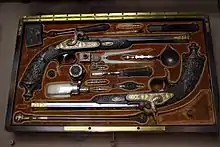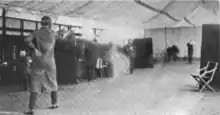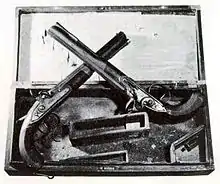Duelling pistol
A duelling pistol is a type of pistol that was manufactured in matching pairs to be used in a duel, when duels were customary. Duelling pistols are often single-shot flintlock or percussion black-powder pistols which fire a lead ball. They were made in identical pairs to put both duelists on the same footing. Not all fine pairs of pistols are actual duelling pistols, though they may be called so.

Design

Standard flintlock pistols can have a noticeable delay between pulling the trigger and actually firing the bullet unless precisely tuned. Purpose-built duelling pistols have various improvements to make them more reliable and accurate.
Duelling pistols have long and heavy barrels - the added weight helped steady aim and reduce recoil. The barrels on earlier guns were cylindrical, while later ones tended to be octagonal. The barrels were given a blued or browned finish to reduce glare.[1] Spurs on the trigger guards began appearing after around 1805 to provide a rest for the middle finger to improve the shooter's grip.[1] Other features were saw handles, platinum-lined touch-holes and hair triggers.
All component parts were manufactured, hand-finished and then adjusted with great care and precision, which made duelling pistols much more costly than standard firearms of the period. Special care was taken when moulding the lead bullets to ensure that there were no voids which would affect accuracy. Pistols were carefully and identically loaded, and each duellist was offered his choice of the indistinguishable loaded pistols. As duels were generally fought at short distances which were paced out, typically 35 to 45 feet (11 to 14 m),[2] between stationary opponents, extreme accuracy was not required.[3]
Duelling pistols had long barrels - typically around 10 in (250 mm) and fired large, heavy bullets. Pistols with calibers of 0.45 in (11 mm), 0.52 in (13 mm), 0.58 in (15 mm) or even 0.65 in (17 mm) were common.[4] The bullets loaded in them could weigh 214 grains (0.49 ounces; 13.9 grams) in .52 caliber or more in larger calibers. Bullets were fired with a muzzle velocity of approximately 830 ft/s (253 m/s), which made a .52 caliber bullet about as lethal as a current .45 ACP round - and therefore capable of inflicting very severe wounds (though speeds of over 385 m/s[5] and averages between 305-610 m/s[6] were also easily achievable and more common with normal flintlock pistols). These injuries, coupled with the primitive state of emergency medicine at the time when duels were commonplace, meant that pistol duels frequently resulted in fatalities, often some hours or days afterwards. This was the fate of Alexander Pushkin, a highly experienced pistol duellist who had fought 29 duels before being wounded in the stomach by Georges-Charles de Heeckeren d'Anthès on 8 February 1837. Pushkin managed to return fire, slightly wounding d'Anthès, but died two days later.[7]
Most English pistols had smooth bores, though some had scratch rifling, a subtle form of rifling which was difficult to see with the naked eye. Pistols with rifled barrel spin-stabilize the shot when it is fired, resulting in much improved accuracy. As a result, duelling pistols with rifled barrels were considered unsporting by many, although there was no unfairness so long as the pistols were identical.[4] For some in the eighteenth century, duelling with less-accurate, smooth-bore weapons were preferred as it they viewed it as allowing the judgement of God to take a role in deciding the outcome of the encounter.[8]
In continental Europe, the use of smooth-bored pistols was considered cowardly, and rifled pistols were the norm.[9] The short range most duels took place at, combined with the accuracy of rifled pistols meant their use substantially increased the chances of a fatality during a duel.[9] A pair of rifled pistols often included a small hammer as an accessory; they used slightly oversized bullets and a hammer was needed to drive the bullet down the barrel when loading.[8] Pairs of duelling pistols can be easily confused with holster pistols and travelling pistols. These types are similar to duelling pistols in that they are large, muzzle-loading weapons, that were often expensively made and came in matched, cased pairs with a set of accessories. Travelling pistols, also known as overcoat pistols, were intended for use by travellers to protect themselves from highwaymen and footpads; unlike duelling pistols, they were commonly rifled. Holster pistols were carried in pairs in a leather holster slung across a horse's saddle. Although best suited for military use, they were often owned by civilians. Although their purpose was combat or self-defense, holster pistols were used on occasion to fight duels.[8]
Sport duelling pistols

During the late 19th and the early 20th centuries, duelling became a sport in which shooters fired at each other using non-lethal rounds. These consisted of wax bullets in a cartridge without any powder charge; the bullet was propelled only by the explosion of the cartridge's primer.[10] Participants wore heavy, protective clothing and a metal helmet, similar to a fencing mask but with an eye-screen of thick glass. Pistol dueling was an associate (non-medal) event at the 1906 and 1908 Olympic games (see Olympic dueling).
The Fauré Le Page company of France made special pistols for sport duelling. These were Break action, single-shot weapons that were fitted with a shield in front of the trigger, to protect the hand holding the pistol.[11]
Manufacturers
The use of pistols in duels became popular in Britain, France and America during the mid-eighteenth century. Initially standard holster or travelling pistols were mainly used, but by the end of the century special-purpose duelling pistols were being made by craftsmen in England, France, Germany, Austria and America.[4]
The most famous and innovative manufacturers were London-based companies such as Wogdon & Barton, Durs Egg, Manton, Mortimer, Nock, and Purdey.[4]
Pairs of duelling pistols were often supplied in compartmentalised wooden cases along with a powder flask, rods for cleaning and loading, spare flints, spanners and other tools, and a bullet mould.[3]
Gallery
.jpg.webp)
 Earlier English flintlock duelling pistols made by Wogdon & Barton, used in the fatal Burr-Hamilton duel of 1804
Earlier English flintlock duelling pistols made by Wogdon & Barton, used in the fatal Burr-Hamilton duel of 1804
See also
| Wikimedia Commons has media related to Duelling pistols. |
- Code duello
- Philip Hamilton (died in 1801, approximately 14 hours after being wounded in a pistol duel)
- Burr–Hamilton duel (Alexander Hamilton died in 1804, after 31 hours of being wounded)
- Charles Dickinson (died in 1806 after being shot by Andrew Jackson, who was himself severely wounded)
- Stephen Decatur (died in 1820, approximately 12 hours after being wounded in a pistol duel)
- John Scott (editor) (died in 1821, 11 days after being wounded in a pistol duel)
- Évariste Galois (died in 1832, approximately 24 hours after being wounded in a pistol duel)
- Thomas Pitt, 2nd Baron Camelford (died in 1804, 3 days after being wounded in a pistol duel)
- Alexander Pushkin (died in 1837, of wounds received in a pistol duel 2 days earlier)
- James Alexander Seton (died in 1845, of wounds received in a pistol duel 13 days earlier)
- Broderick–Terry duel (Senator Broderick died in 1859, approximately 3 days after being wounded)
- Lucius M. Walker (died in 1863, approximately 36 hours after being wounded in a pistol duel)
- Ferdinand Lassalle (died in 1874, 3 days after being wounded in a pistol duel)
- List of people killed in duels
References
- Jeff Kinard (2003). Pistols: An Illustrated History of Their Impact. ABC-CLIO. pp. 29–. ISBN 978-1-85109-470-7.
- "www.exetermemories.co.uk/EM/_events/last_duel.php". Archived from the original on 2008-11-20.
- Kinard, Jeff (2004). Pistols: An Illustrated History of Their Impact. ABC-CLIO. pp. 29–30. ISBN 978-1-85109-470-7.
- Flayderman, Norm (17 December 2007). Flayderman's Guide to Antique American Firearms and Their Values (9 ed.). Iola, Wisconsin: F+W Media, Inc. pp. 453–454. ISBN 0-89689-455-X.
- https://journals.lib.unb.ca/index.php/MCR/article/view/17669/22312#no10
- https://science.howstuffworks.com/flintlock3.htm
- Cohen, Richard (10 June 2010). By the Sword: Gladiators, Musketeers, Samurai Warriors, Swashbucklers and Olympians. New York: Simon and Schuster. pp. 133–134. ISBN 978-1-84983-166-6.
- Jeff Kinard (2003). Pistols: An Illustrated History of Their Impact. ABC-CLIO. pp. 33–34. ISBN 978-1-85109-470-7.
- Pauly, Roger (1 January 2004). Firearms: The Life Story of a Technology. Greenwood Publishing Group. p. 69. ISBN 978-0-313-32796-4.
- "Duel With Wax Bullets" (PDF). The New York Times. February 26, 1909. Retrieved 24 December 2014.
- McCollum, Ian (2018-01-03). "Lepage Wax-Bullet Dueling Pistols". Forgotten Weapons. Retrieved 2019-12-10.